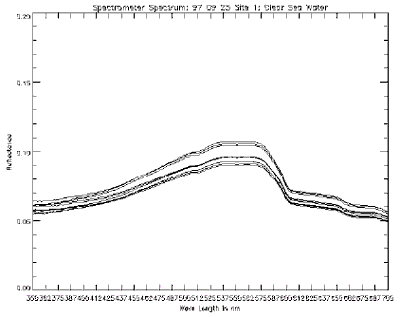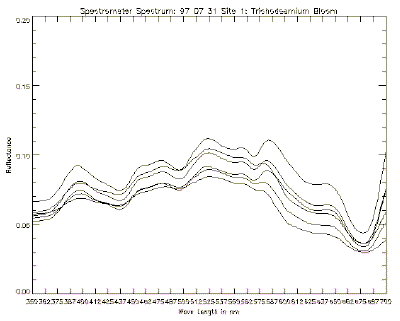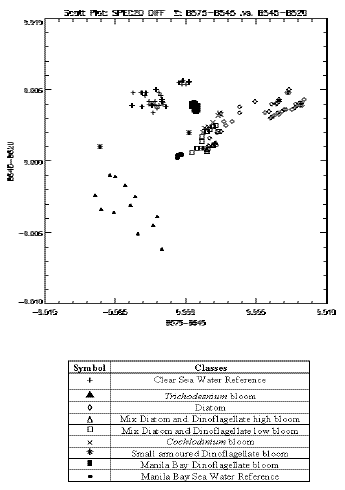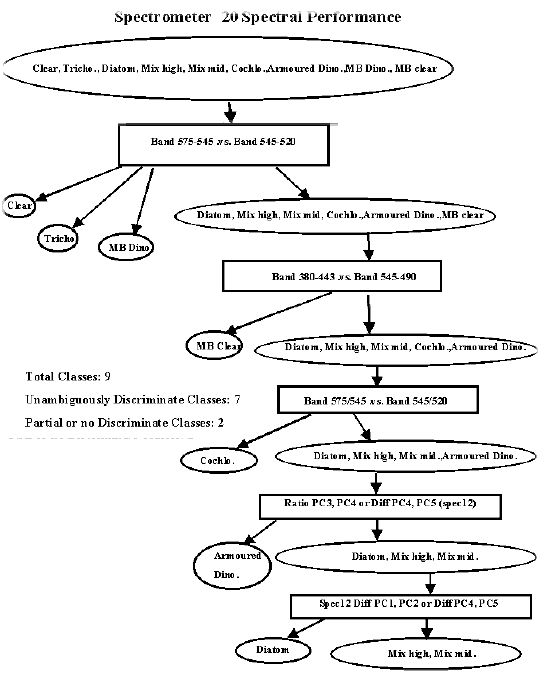| GISdevelopment.net ---> AARS ---> ACRS 1999 ---> Land Use |
Classification of Tropical
Algal Bloom Types by Sea Truth Spectral-Radiometric Data
I-I Lin*, Soo Chin Liew,
Hock Lim, Leong Keong Kwoh, Michael Holmes, Serena Teo, Siong Teck Koh,
and Karina Gin
Centre for Remote Imaging, Sensing and Processing,
Faculty of Science, National University of Singapore
Lower Kent Ridge Road, Singapore 119260
Tel: 65-8747908 Fax: 65-7757717
Email: crslinii@leonis.nus.edu.sg
Centre for Remote Imaging, Sensing and Processing,
Faculty of Science, National University of Singapore
Lower Kent Ridge Road, Singapore 119260
Tel: 65-8747908 Fax: 65-7757717
Email: crslinii@leonis.nus.edu.sg
Keywords: Red Tides, Classification,
Spectral-Radiometric Data, Ocean Colour
Abstract
Algal blooms are important ocean biological phenomena which has strong social economic and health impact. Algal blooms are related to the ocean primary production. However, there are also Harmful Algal Blooms (HAB) or Red Tides as some bloom types are of toxic species. Human consumption of contaminated fish or shellfish may cause death and other sickness. There are more reports of harmful algal blooms in the whole Asia region in recent years than before. Traditional algal bloom monitoring is carried out through regular in situ ship borne water sampling programmes. However, these sampling programmes are discrete point measurements and can not provide sufficient spatial and temporal coverage to monitor these complex dynamic phenomena. There is a real need to use remote sensing in identifying bloom coverage and bloom types. This research studied the spectral-radiometric measurements of 7 bloom types collected in various locations of Asia. It is found that each bloom type has unique spectral signature and it is possible to classify different bloom types from there spectral signature. This provides a basis for identification of bloom types from satellite-borne hyperspectral and ocean colour sensors.
1. Introduction
Phytoplankton are algae, microscopic plants that float in the surface waters of the sea, lakes, and rivers. In the ocean they constitute the base of the marine food web. Algal blooms are biological phenomena referring to the situation whereby there is a high cell concentration of phytoplankton. As phytoplankton is the base of marine food web, algal blooms are thus related to the ocean primary production. The identification and monitoring of these blooms are often considered as a viable means to locate new fishing grounds. Thus algal bloom monitoring has a positive impact on economy especially for countries of strong dependence on fishery industry. However, not all algal blooms are beneficial to humans. Often the terms 'Harmful Algal Bloom (HAB)' or 'Red Tides' are used to describe algal blooms which causes negative impacts to humans. Red tide is a general term simply referring the accumulations of phytoplankton so dense that the water appears to be colored. Sometimes, 'Red Tide' is used to refer to blooms which produce toxins. However, it is not a specific term. Most phytoplankton blooms are not red-colored, they can be brown or gray or have no color at all. Harmful Algal Blooms (HABs) is a better and more popular term, which more accurately, describes the phenomena (Hallegraeff and Maclean, 1989). HABs commonly refer to blooms of which directly or indirectly cause discomfort or toxic effects on humans (Richardson, 1997). In Southeast Asia, red tides or HABs have been observed in many coastal waters (Hallegraeff and Maclean, 1989), e.g., in Bays in the Philippines (Hallegraeff and Maclean, 1989; Coralles and Gomez, 1990; Abuso et al., 1996), in Brunei Darussalam's coastal waters, and off Sabah, Malaysia (Abuso et al., 1996).
Algal blooms may also cause harm by shading other aquatic life. When bloom collapses the microbial respiration on the dead and decaying cells can lead to reduced oxygen concentrations that can kill fish and other aquatic organisms due to lack of oxygen. In situation whereby a bloom is dominated by toxic algal species, toxins can be accumulated in the food chain and eventually be consumed by humans to cause paralytic or diarrhetic shellfish poisoning (Corrales and Gomez, 1990). Table 1 summarises some facts and figures about red tide in the year 1998.
Table 1: Facts and figures about red tides in 1998.
With these significant social economical and health impacts, it is thus an important task to monitor algal blooms in most of the countries world wide. Traditionally algal bloom monitoring is carried out through regular in situ ship borne water sampling programmes. However, these sampling programmes are discrete point measurements and can not provide sufficient spatial and temporal coverage to monitor these complex dynamic phenomena. With its synoptic coverage, frequent revisit, high observing efficiency, and relatively low cost, remote sensing technique has been identified as an important complementary tool for the monitoring. This work studied the spectral signatures of different red tide bloom classes taken during a 2 year sea truth sampling programme. A GER field spectral-radiometer were used to collected the bloom spectra. The analysis of the spectra provides a basis for classification of the bloom types from satellite ocean colour and hyperspectral data.
2. Description of Different Algal Bloom Classes
In this research, 7 different classes of algal blooms were studied. These 7 bloom classes were Trichodesmiun, chain-forming diatom, "mixed diatom and high dinoflagellates bloom", "mixed diatom and low dinoflagellates bloom", Cochlodinum, small armoured dinoflagellate, and dinoflagellates from Manila Bay. Among the 7 bloom classes, 6 blooms samples were collected in Johor Strait, Singapore while one bloom was from Manila Bay, Philippines.
Among the 7 bloom classes, the Trichodesmiun bloom belongs to cyanobacteria (blue-green algae). During the 2 years sampling in Singapore, many of the bloom events were from diatoms, especially chain-forming diatoms. "Mixed diatom and dinoflagellate blooms" were blooms in which both diatom and dinoflagellate dominate. There are 2 such classes, one of higher dinoflagellate cell counts and the other of lower dinoflagellate cell counts. Cochlodinium and small armoured dinoflagellate blooms are dinoflagellate blooms. The major species in the Manila Bay dinoflagellate samples was Ceratium furca. There were also Pyrodinium bahamense (var. compressum) which is the notorious toxic red tide species that occurs in Manila Bay every year. Two reference classes were used for comparison, one from Johor, Singapore and the other from the Manila Bay. These samples contained low phytoplankton counts to compare with the bloom (high phytoplankton count) classes.
3. Spectral Signature of Different Algal Bloom Classes
From the collected spectral-radiometric spectra, it is found that different bloom classes are characterised by different spectra. In this section, spectra from clear, Trichodesmium, and chain forming diatom classes are shown and discussed. Figure 1 illustrates the original spectra of clear water samples. Clear sea water samples are reference samples taken from Singapore water samples of low TSS (< 10.2 mg/l), low chlorophyll (< 3.75 mg/m3 ), and low phytoplankton counts (< 100 cells/l). It can be seen from the figure that there is only 1 peak at 560nm in the green region which is typical for case-II waters.

Fig. 1: Typical spectra of clear sea water between the range 350nm to 700nm.
Trichodesmium is a species of cyanobacteria (blue-green algae). It is commonly found in the region of south east Asia and Australia. Although not a toxic phytoplankton species, it is the number 1 fish killer in Thailand, Indonesia, and Malaysia. (Azanza, 1998 personal communication). The Trichodesmium bloom discussed in this research occurred on 30th-31st July 1997 at the eastern part of Singapore off Bedok coast. The bloom was characterised by orange-brown patches with typical dimension 0.5m by 5m.The Trichodesnium count was estimated to be 210,000 cells/l. Figure 2 illustrates typical spectra of Trichodesmium. It can be seen that 2 chlorophyll A absorption bands at 443nm and 660nm showing clear absorption characteristics. Another clear trough is found at band 490nm correspondent with the pigment absorption. At 520nm band a peak is observed since this band is sensitive to red tides. A further peak is observed at 625nm band. This 625 band is sensitive to the sediments.

Fig. 2: Typical spectra of the Trichodesmiun bloom between the range 350nm to 700nm.
Chain forming diatom blooms are the most common type of phytoplankton bloom occurred in the Johor Strait, Singapore. In general, most tropical diatoms belong to non-toxic species. Figure 3 shows typical spectra of such blooms. It can be seen from the figure that the spectral characteristics of chain forming diatom bloom is very different from Trichodesmium and clear water spectra. Besides from the 560nm peak of case 2 sea water, there is another peak found at around 690nm region. In addition, there are no distinct peaks and troughs in other specific bands, e.g., at 490nm pigment absorption band or at 520nm, the red tide sensitive band.

Fig. 3: Typical spectra of a Diatom bloom between the range 350nm to 700nm.
4. Spectral Analysis
In order to extract useful information from the multispectral data, different combinations of reflectance difference and reflectance ratio of the available bands are tested. In addition, Principal Component Analysis (PCA) are also implemented. These analyses are combined to assess the sensitivity in differentiating different algal bloom types by the collected spectra. Figure 4 illustrates a scatter plot of all the 9 classes based on the reflectance difference between band 575nm-545nm .vs. band 545nm-520nm. It can be seen from the figure that with the combination of these 2 sets of bands, 4 classes can be unambiguously differentiated. These classes are clear sea water reference (+), Trichodesmiun bloom, Manila Bay reference classes (·), and the Manila Bay dinoflagellates ( ). It can also be seen from the scatter plots of other band combinations (not shown here) that each combination of band reflectance difference, ratio, and principal components give different separation of the 9 classes. As such, an algorithm can be proposed which utilises band manipulation and combination to achieve the highest possible separability. Figure 5 illustrates such an algorithm. It can be seen that among all the 9 classes, 7 classes can be unambiguously separated.

Figure 4: Scatter plot of the 9 classes by their band difference. The X axis is the reflectance difference between band 575nm and 545nm. The Y axis is the reflectance difference between band 545nm and 520nm.

Figure 5: Spectral analysis suggests a proposed algorithm which utilises the combination of spectral bands to achieve separation of different bloom classes.
5. Conclusions
This research studied the spectral characteristics of 7 different algal bloom classes collected during a 2 years sampling programme in different parts of Asia. It has found that different algal bloom classes are characterised by different spectral signature in the ocean colour region (350nm-700nm) of the spectra. The picks and troughs observed in the spectra are related to different phytoplankton properties, e.g., chlorophyll-A absorption, and pigment absorption. The result suggests the feasibility of differentiating algal bloom types by their reflectance spectra. An algorithm which utilises the combination of reflectance band difference and ratio for bloom classification is also proposed. The possibility of differentiating and identification of algal bloom types by satellite hyperspectral and ocean colour data is suggested. Further research is in progress to develop various techniques in utilising the spectral information to improve classification.
6. Acknowledgements
This study is partially supported by the National Space Development Agency of Japan through the joint NASDA-ESCAP project entitled 'National capacity building for sustainable environment and natural resources management through research and studies on the uses of ADEOS data".
7. References
Abstract
Algal blooms are important ocean biological phenomena which has strong social economic and health impact. Algal blooms are related to the ocean primary production. However, there are also Harmful Algal Blooms (HAB) or Red Tides as some bloom types are of toxic species. Human consumption of contaminated fish or shellfish may cause death and other sickness. There are more reports of harmful algal blooms in the whole Asia region in recent years than before. Traditional algal bloom monitoring is carried out through regular in situ ship borne water sampling programmes. However, these sampling programmes are discrete point measurements and can not provide sufficient spatial and temporal coverage to monitor these complex dynamic phenomena. There is a real need to use remote sensing in identifying bloom coverage and bloom types. This research studied the spectral-radiometric measurements of 7 bloom types collected in various locations of Asia. It is found that each bloom type has unique spectral signature and it is possible to classify different bloom types from there spectral signature. This provides a basis for identification of bloom types from satellite-borne hyperspectral and ocean colour sensors.
1. Introduction
Phytoplankton are algae, microscopic plants that float in the surface waters of the sea, lakes, and rivers. In the ocean they constitute the base of the marine food web. Algal blooms are biological phenomena referring to the situation whereby there is a high cell concentration of phytoplankton. As phytoplankton is the base of marine food web, algal blooms are thus related to the ocean primary production. The identification and monitoring of these blooms are often considered as a viable means to locate new fishing grounds. Thus algal bloom monitoring has a positive impact on economy especially for countries of strong dependence on fishery industry. However, not all algal blooms are beneficial to humans. Often the terms 'Harmful Algal Bloom (HAB)' or 'Red Tides' are used to describe algal blooms which causes negative impacts to humans. Red tide is a general term simply referring the accumulations of phytoplankton so dense that the water appears to be colored. Sometimes, 'Red Tide' is used to refer to blooms which produce toxins. However, it is not a specific term. Most phytoplankton blooms are not red-colored, they can be brown or gray or have no color at all. Harmful Algal Blooms (HABs) is a better and more popular term, which more accurately, describes the phenomena (Hallegraeff and Maclean, 1989). HABs commonly refer to blooms of which directly or indirectly cause discomfort or toxic effects on humans (Richardson, 1997). In Southeast Asia, red tides or HABs have been observed in many coastal waters (Hallegraeff and Maclean, 1989), e.g., in Bays in the Philippines (Hallegraeff and Maclean, 1989; Coralles and Gomez, 1990; Abuso et al., 1996), in Brunei Darussalam's coastal waters, and off Sabah, Malaysia (Abuso et al., 1996).
Algal blooms may also cause harm by shading other aquatic life. When bloom collapses the microbial respiration on the dead and decaying cells can lead to reduced oxygen concentrations that can kill fish and other aquatic organisms due to lack of oxygen. In situation whereby a bloom is dominated by toxic algal species, toxins can be accumulated in the food chain and eventually be consumed by humans to cause paralytic or diarrhetic shellfish poisoning (Corrales and Gomez, 1990). Table 1 summarises some facts and figures about red tide in the year 1998.
Table 1: Facts and figures about red tides in 1998.
| Location | Time/Event |
| Hong Kong | Mar-Apr 1998 Wiped off Hong Kong Fishery Industry (1000 fish farms) in 1998. The estimated lost is around 10 million US$. |
| Hong Kong | Nov 1998 |
| Sabah, Malaysia | May 1998 Toxic event, shell fish found to contain toxin at 5 times hazardous level. |
| Canada | July 1998 (Affected an area 150km long by 2-3 km wide) Toxic species: Alexandrium tamarense. |
| Manila Bay, Philippines | August 1998 (Toxic species: Pyrodinium Bahamense) At least 2 persons died after eating polluted shell fish. |
With these significant social economical and health impacts, it is thus an important task to monitor algal blooms in most of the countries world wide. Traditionally algal bloom monitoring is carried out through regular in situ ship borne water sampling programmes. However, these sampling programmes are discrete point measurements and can not provide sufficient spatial and temporal coverage to monitor these complex dynamic phenomena. With its synoptic coverage, frequent revisit, high observing efficiency, and relatively low cost, remote sensing technique has been identified as an important complementary tool for the monitoring. This work studied the spectral signatures of different red tide bloom classes taken during a 2 year sea truth sampling programme. A GER field spectral-radiometer were used to collected the bloom spectra. The analysis of the spectra provides a basis for classification of the bloom types from satellite ocean colour and hyperspectral data.
2. Description of Different Algal Bloom Classes
In this research, 7 different classes of algal blooms were studied. These 7 bloom classes were Trichodesmiun, chain-forming diatom, "mixed diatom and high dinoflagellates bloom", "mixed diatom and low dinoflagellates bloom", Cochlodinum, small armoured dinoflagellate, and dinoflagellates from Manila Bay. Among the 7 bloom classes, 6 blooms samples were collected in Johor Strait, Singapore while one bloom was from Manila Bay, Philippines.
Among the 7 bloom classes, the Trichodesmiun bloom belongs to cyanobacteria (blue-green algae). During the 2 years sampling in Singapore, many of the bloom events were from diatoms, especially chain-forming diatoms. "Mixed diatom and dinoflagellate blooms" were blooms in which both diatom and dinoflagellate dominate. There are 2 such classes, one of higher dinoflagellate cell counts and the other of lower dinoflagellate cell counts. Cochlodinium and small armoured dinoflagellate blooms are dinoflagellate blooms. The major species in the Manila Bay dinoflagellate samples was Ceratium furca. There were also Pyrodinium bahamense (var. compressum) which is the notorious toxic red tide species that occurs in Manila Bay every year. Two reference classes were used for comparison, one from Johor, Singapore and the other from the Manila Bay. These samples contained low phytoplankton counts to compare with the bloom (high phytoplankton count) classes.
3. Spectral Signature of Different Algal Bloom Classes
From the collected spectral-radiometric spectra, it is found that different bloom classes are characterised by different spectra. In this section, spectra from clear, Trichodesmium, and chain forming diatom classes are shown and discussed. Figure 1 illustrates the original spectra of clear water samples. Clear sea water samples are reference samples taken from Singapore water samples of low TSS (< 10.2 mg/l), low chlorophyll (< 3.75 mg/m3 ), and low phytoplankton counts (< 100 cells/l). It can be seen from the figure that there is only 1 peak at 560nm in the green region which is typical for case-II waters.

Fig. 1: Typical spectra of clear sea water between the range 350nm to 700nm.
Trichodesmium is a species of cyanobacteria (blue-green algae). It is commonly found in the region of south east Asia and Australia. Although not a toxic phytoplankton species, it is the number 1 fish killer in Thailand, Indonesia, and Malaysia. (Azanza, 1998 personal communication). The Trichodesmium bloom discussed in this research occurred on 30th-31st July 1997 at the eastern part of Singapore off Bedok coast. The bloom was characterised by orange-brown patches with typical dimension 0.5m by 5m.The Trichodesnium count was estimated to be 210,000 cells/l. Figure 2 illustrates typical spectra of Trichodesmium. It can be seen that 2 chlorophyll A absorption bands at 443nm and 660nm showing clear absorption characteristics. Another clear trough is found at band 490nm correspondent with the pigment absorption. At 520nm band a peak is observed since this band is sensitive to red tides. A further peak is observed at 625nm band. This 625 band is sensitive to the sediments.

Fig. 2: Typical spectra of the Trichodesmiun bloom between the range 350nm to 700nm.
Chain forming diatom blooms are the most common type of phytoplankton bloom occurred in the Johor Strait, Singapore. In general, most tropical diatoms belong to non-toxic species. Figure 3 shows typical spectra of such blooms. It can be seen from the figure that the spectral characteristics of chain forming diatom bloom is very different from Trichodesmium and clear water spectra. Besides from the 560nm peak of case 2 sea water, there is another peak found at around 690nm region. In addition, there are no distinct peaks and troughs in other specific bands, e.g., at 490nm pigment absorption band or at 520nm, the red tide sensitive band.

Fig. 3: Typical spectra of a Diatom bloom between the range 350nm to 700nm.
4. Spectral Analysis
In order to extract useful information from the multispectral data, different combinations of reflectance difference and reflectance ratio of the available bands are tested. In addition, Principal Component Analysis (PCA) are also implemented. These analyses are combined to assess the sensitivity in differentiating different algal bloom types by the collected spectra. Figure 4 illustrates a scatter plot of all the 9 classes based on the reflectance difference between band 575nm-545nm .vs. band 545nm-520nm. It can be seen from the figure that with the combination of these 2 sets of bands, 4 classes can be unambiguously differentiated. These classes are clear sea water reference (+), Trichodesmiun bloom, Manila Bay reference classes (·), and the Manila Bay dinoflagellates ( ). It can also be seen from the scatter plots of other band combinations (not shown here) that each combination of band reflectance difference, ratio, and principal components give different separation of the 9 classes. As such, an algorithm can be proposed which utilises band manipulation and combination to achieve the highest possible separability. Figure 5 illustrates such an algorithm. It can be seen that among all the 9 classes, 7 classes can be unambiguously separated.

Figure 4: Scatter plot of the 9 classes by their band difference. The X axis is the reflectance difference between band 575nm and 545nm. The Y axis is the reflectance difference between band 545nm and 520nm.

Figure 5: Spectral analysis suggests a proposed algorithm which utilises the combination of spectral bands to achieve separation of different bloom classes.
5. Conclusions
This research studied the spectral characteristics of 7 different algal bloom classes collected during a 2 years sampling programme in different parts of Asia. It has found that different algal bloom classes are characterised by different spectral signature in the ocean colour region (350nm-700nm) of the spectra. The picks and troughs observed in the spectra are related to different phytoplankton properties, e.g., chlorophyll-A absorption, and pigment absorption. The result suggests the feasibility of differentiating algal bloom types by their reflectance spectra. An algorithm which utilises the combination of reflectance band difference and ratio for bloom classification is also proposed. The possibility of differentiating and identification of algal bloom types by satellite hyperspectral and ocean colour data is suggested. Further research is in progress to develop various techniques in utilising the spectral information to improve classification.
6. Acknowledgements
This study is partially supported by the National Space Development Agency of Japan through the joint NASDA-ESCAP project entitled 'National capacity building for sustainable environment and natural resources management through research and studies on the uses of ADEOS data".
7. References
- Abuso, Z.V., et al., 1996, Final Meeting ASEAN-Canada Red Tide Network.
- Corrales, R.A. and E.D. Gomez, 1990, in Toxic Marine Phytoplankton, 453-458, Elsevier.
- Doerffer, R., 1990, ICES Statutory Meeting, Copenhagen.
- Gordon, H.R. and A.Y. Morel, 1981, in Oceanography from Space, 207-212.
- Hallegraeff G. M. and Maclean J.L. (eds), 1989 Biology,, Epidemiology and Management of
- Pyrodinium Red Tides. ICLARM Conf Proc. 21.pp 1-7.
- Hovis, W.A., 1981, in Oceanography from Space, 213-225.
- Kahru, M. and Brown C.W., 1997, Monitoring Algal Blooms – New Techniques for Detecting
- Large-Scale Environmental Change, Springer, Berlin Germany.
- NASDA (1998) Proceedings Of the 3 rd ADEOS Symposium, 26-30 January 1998, Sendei, Japan.
- Richardson, K. (1997) Harmful or Exceptional Phytoplankton Blooms in the Marine ecosystem. Adv. Mar. Biol. 31: 301-385.